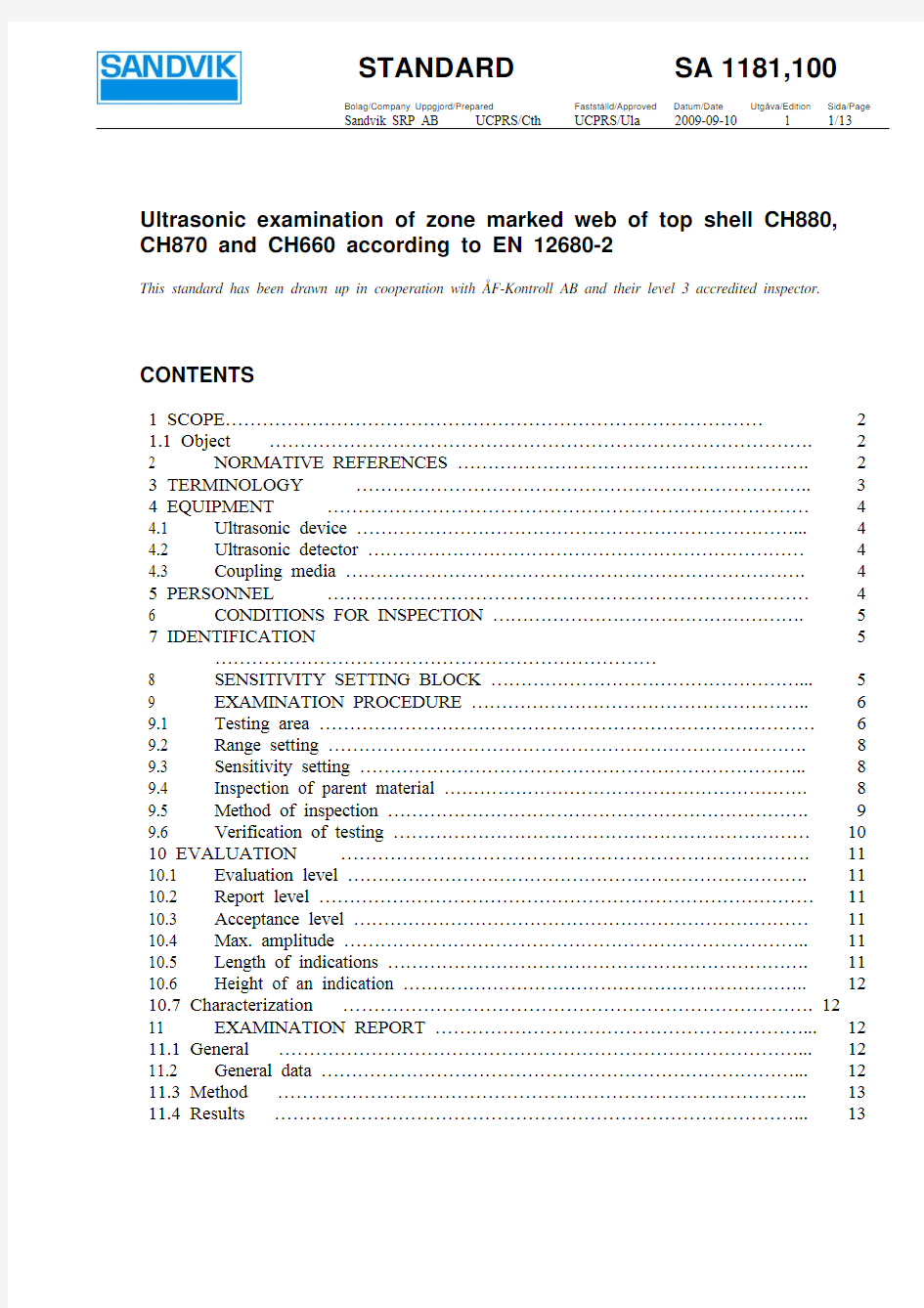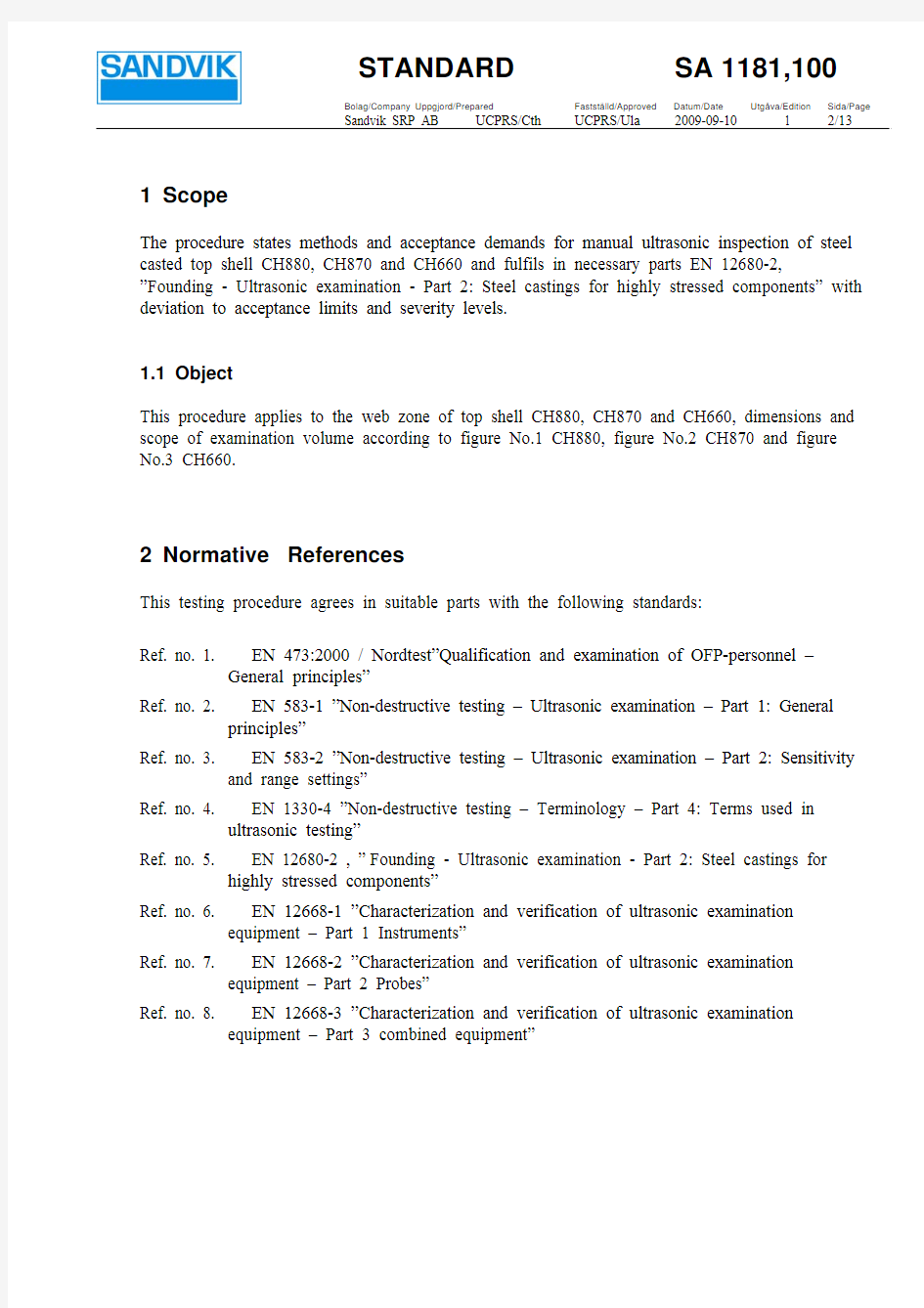

Ultrasonic examination of zone marked web of top shell CH880,
CH870 and CH660 according to EN 12680-2
This standard has been drawn up in cooperation with ?F-Kontroll AB and their level 3 accredited inspector.
CONTENTS
1 SCOPE (2)
(2)
1.1 Object
2 NORMATIVE REFERENCES (2)
(3)
3 TERMINOLOGY
(4)
4 EQUIPMENT
4.1 Ultrasonic device (4)
4.2 Ultrasonic detector (4)
4.3 Coupling media (4)
(4)
5 PERSONNEL
6 CONDITIONS FOR INSPECTION (5)
5 7 IDENTIFICATION
………………………………………………………………
8 SENSITIVITY SETTING BLOCK (5)
9 EXAMINATION PROCEDURE (6)
9.1 Testing area (6)
9.2 Range setting (8)
9.3 Sensitivity setting (8)
9.4 Inspection of parent material (8)
9.5 Method of inspection (9)
9.6 Verification of testing (10)
(11)
10 EVALUATION
10.1 Evaluation level (11)
10.2 Report level (11)
10.3 Acceptance level (11)
10.4 Max. amplitude (11)
10.5 Length of indications (11)
10.6 Height of an indication (12)
(12)
10.7 Characterization
11 EXAMINATION REPORT (12)
(12)
11.1 General
11.2 General data (12)
(13)
11.3 Method
(13)
11.4 Results
1 Scope
The procedure states methods and acceptance demands for manual ultrasonic inspection of steel casted top shell CH880, CH870 and CH660 and fulfils in necessary parts EN 12680-2,
”Founding - Ultrasonic examination - Part 2: Steel castings for highly stressed components” with deviation to acceptance limits and severity levels.
1.1 Object
This procedure applies to the web zone of top shell CH880, CH870 and CH660, dimensions and scope of examination volume according to figure No.1 CH880, figure No.2 CH870 and figure No.3 CH660.
2 Normative References
This testing procedure agrees in suitable parts with the following standards:
Ref. no. 1. EN 473:2000 / Nordtest”Qualification and examination of OFP-personnel – General principles”
Ref. no. 2. EN 583-1 ”Non-destructive testing – Ultrasonic examination – Part 1: General principles”
Ref. no. 3. EN 583-2 ”Non-destructive testing – Ultrasonic examination – Part 2: Sensitivity and range settings”
Ref. no. 4. EN 1330-4 ”Non-destructive testing – Terminology – Part 4: Terms used in ultrasonic testing”
Ref. no. 5. EN 12680-2 , ”Founding - Ultrasonic examination - Part 2: Steel castings for highly stressed components”
Ref. no. 6. EN 12668-1 ”Characterization and verification of ultrasonic examination equipment – Part 1 Instruments”
Ref. no. 7. EN 12668-2 ”Characterization and verification of ultrasonic examination equipment – Part 2 Probes”
Ref. no. 8. EN 12668-3 ”Characterization and verification of ultrasonic examination equipment – Part 3 combined equipment”
3 Terminology
The terminology and definitions follow EN 1330-4 [4] and dimensions and designations given in table 1.
Designation Name Unit
T Base material thickness at thinnest point [mm]
D SDH Diameter of a transverse hole [mm]
l Length of an indication [mm]
h Height of an indication [mm]
x Position of an indication transversely [mm]
y Position of an indication’s depth [mm]
z Position of an indication longitudinally [mm]
lz Position of an indication’s projected length in y-axis [mm]
lx Position of an indication’s projected length in x-axis [mm]
ly Position of an indication’s projected length in depth. [mm]
p Skipped distance [mm]
Table 1 Dimensions and designations
4 Equipment
4.1 Ultrasonic device
The ultrasonic device shall be of the impulse echo type with a gain control calibrated in stages of max 2dB and meet the requirements given in EN 12680-2 and EN 12668-1.
The ultrasonic examination equipment shall be checked regularly by the operator according to EN12668-3.
4.2 Ultrasonic detector
The probes shall fulfill the designated demands in EN 12668-2.
The ultrasonic probes used for testing shall be of normal and angular single crystal type. The frequency of the ultrasonic probe shall be in the range 1 – 6 MHz.
Angular probes shall have an incident angle toward the reflecting surface of 45° to 70°.
4.3 Coupling media
Ultrasonic gel, water, oil or wallpaper glue can be used as a coupling medium. The same coupling medium shall be used for calibration and all subsequent examination operations.
5 Personnel
Ultrasonic examination according to this procedure shall be performed by qualified and capable personal, certified in accordance with EN 473:2000/Nordtest level 1, industrial sector 3, or equivalent certification system.
6 Conditions for inspection
The surfaces to be scanned shall be sufficiently wide to cover the whole inspection volume. The scanned surfaces shall be free from rust, scales, welding splatter, grooves and similar that could interfere with the detector coupling.
Unevenness of the test surface may not cause a larger gap than 0.5mm between the probe and test surface.
The scanned surface and reflective surface shall have a surface finish that does not exceed Ra 12.5 μm.
7 Identification
It shall be possible to uniquely identify the tested object before and after performed examination. Identification constitutes of reference to drawings and the Top Shells unique serial number.
8 Sensitivity setting block
The reference level shall be determined using a reference block manufactured according to EN 12668-3 with ?5.0 mm side drilled holes, marked with a unique identification number and made in a material exhibiting similar acoustic properties to those of the material to be examined.
9 Examination procedure
9.1 Testing area
The examined volume is defined as the volume located between 200mm above to 50 mm below the web. Due to the complex geometrical construction in this area of the top shell, extra precautions shall be taken when evaluating indications located at y > T. (See figure 1 - 3).
Figure 1: CH660
Figure 2: CH870
Figure 3: CH880
9.2 Range setting
Prior to examination range setting shall be carried out in accordance with EN 583-2 using one of the two options given below.
?With the calibration block in accordance with No. 1 EN 12223
?With an alternative calibration block made in a material exhibiting similar acoustic properties to those of the material to be examined.
If using the K1 calibration block, variances in the acoustic properties between the materials should be taken into consideration when evaluating indications.
9.3 Sensitivity setting
9.3.1Reference level
The reference level is a distance-amplitude-curve (DAC-curve) for an ?5.0 mm side drilled hole (SDH).
9.3.2 Transfer correction
Transfer correction (correction of transfer losses) shall be performed before testing. Measurement is made at a representative number of points on the object and calibration block. The average values are used to adjust the gain.
If the difference is ≤ 2 dB, no correction is necessary.
If the difference is > 2 dB but ≤ 12 dB, compensation must be made.
If the difference is > 12 dB, the reason shall be determined and corrective actions taken.
9.3.3 Signal to noise ratio
The noise level shall be at least 12 dB below the evaluation level.
9.4 Inspection of parent material
The detection surfaces shall be inspected with a normal probe to show any defective areas or areas with high damping that may negatively affect the inspection.
To ensure that differences in damping appear, at least three back wall echoes should be visible on the instrument display during inspection of the parent material.
9.5 Method of inspection
9.5.1 General
The examination volume shall be inspected with 3 different probes, normal, 45 and 70 degrees from the Top Shells inner surface according to the testing sequences given in figure 1.
rotation
9.5.2 Probe
When scanning with angular probes, the probes shall be moved back and forth with a slight swiveling motion not exceeding ±10° in either side of the nominal sound beam direction.
rate
9.5.3 Scanning
The maximum scanning rate depends on the equipments PRF settings but shall in no cases exceed 150mm/s.
coordinates
9.5.4 Position
The position of all indications shall be made in reference to a previously determined coordinate system given in table 2, figure 4 and 5.
Coordinates for position of indications
X Distance in mm from upper flange
Y Distance in mm from inner surface
Z Position in degrees from arm
Table 2
Before and after completed examination, and every fourth hour, range and sensitivity settings shall be verified. A renewed verification shall also be performed if an essential part of the testing system is replaced.
Range corrections
Deviations ≤ 2% of the range The setting shall be corrected before examination is
continued.
Deviations > 2% of the range Setting shall be corrected an examinations carried
out over the previous period shall be repeated
Sensitivity corrections
Deviations ≤ 4 dB The setting shall be corrected before the
examination is continued.
Reduction of the sensitivity > 4 dB Setting shall be corrected an examinations carried out over the previous period shall be repeated
Increase in sensitivity > 4 dB The setting shall be corrected and all recorded
indications shall be reexamined
Table 3: Range and sensitivity corrections
10 Evaluation
10.1 Evaluation level
All indications greater or equal to the following shall be evaluated
Evaluation level = reference level – 12 dB (25 % DAC).
10.2 Report level
All indications greater or equal to the following shall be reported
Report level = reference level – 6 dB (50 % DAC).
Indications with a length exceeding 10,0 mm shall be reported.
Two indications separated from each other by a distance not exceeding the length of the smallest one should be reported as one coherent indication.
10.3 Acceptance level
All indications greater or equal to the following are not accepted:
Acceptance level = reference level – 6 dB (50 % DAC).
Indications with a length exceeding 20,0mm are not accepted.
Two indications separated from each other by a distance not exceeding the length of the smallest one should be reported as one coherent indication.
10.4 Max. Amplitude
The echo amplitude shall be maximized due to the motion of the detector and shall be registered in relation to the reference level.
10.5 Length of indications
The length of an indication, in longitudinal or transverse direction, shall be determined by the ”-6 dB drop” method.
10.6 Height of an indication
The height of an indication shall be reported on the point where the maximum amplitude was obtained.
10.7 Characterization
EN 12680-2 annex C could be used as informative information regarding types of indications. Further characterization of indications should not be performed.
11 Examination Report
11.1 General
An inspection report shall be written for each tested Top Shell, containing at least the following information.
data
11.2 General
?Reference to this standard
?Positions of inspected areas
?References to welding procedures, specifications and heat treatment, if these have been performed
?Surface characteristics
?Object’s temperature, if outside the range 0 °C – 40 °C
?Place and time of the inspection
?Company name,
?Name of the operator accreditation number and level of the personnel’s certification
?Manufacturer and type of ultrasonic instrument with identification number
?Manufacturer, type, nominal frequency and effective incidence angle for probes
?Identification of reference and calibration blocks
?Coupling media
11.3 Method
?Reference points and coordinate system
?All data necessary for sensitivity settings
?Reference level
?Results of the inspection of the parent material
?Deviations
11.4 Results
?Coordinates for indications with information about probe and probe position ?Maximum echo amplitude
?Length of indications